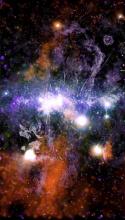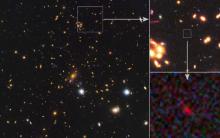Royal Astronomical Society
Scientists challenge dark energy theory
Dark energy, long thought to drive the accelerating of the expansion of the universe, may not exist, according to a groundbreaking study.
The research, based on enhanced light-curve analysis of "type Ia supernovae," suggests the universe expands in a "lumpy" and uneven manner rather than uniformly.
- Read more about Scientists challenge dark energy theory
- Log in to post comments
Age of universe at 26.7 billion years, nearly twice as old as previously believed, new research suggests
The work is published in the journal Monthly Notices of the Royal Astronomical Society
NASA releases stunning new pic of Milky Way's 'downtown'
NASA has released a stunning new picture of our galaxy's violent, super-energized "downtown."
It's a composite of 370 observations over the past two decades by the orbiting Chandra X-ray Observatory, depicting billions of stars and countless black holes in the center, or heart, of the Milky Way. A radio telescope in South Africa also contributed to the image, for contrast.
Astronomers have Found 3 Planets Similar to Earth
The Instituto de Astrofísica de Canarias (IAC) and the University of Oviedo present today the discovery of two new planetary systems, one of them hosting three planets the same size as the Earth.
- Read more about Astronomers have Found 3 Planets Similar to Earth
- Log in to post comments
Matter of Milky Way comes from other galaxies, study suggests
We are all made of star stuff and some of that stuff took a long journey to get here. According to new research, galaxies exchange copious amounts of material, and half of the material that makes up the Milky Way might have originated in another galaxy.
Half of your body may have formed from a galaxy far, far away
“We are all made of stars” used to sing Moby in 2002 and though science has known it for a while, a new study went as far as to claim half of the atoms making up everything around us, and in us, may have formed beyond the Milky Way.
Mystery of the disappearing star – how N6946-BH1 vanished without a trace!
The star N6946-BH1 in a spiral formation 22 million light years away known as the ‘fireworks galaxy’, was last seen by Nasa’s Hubble Telescope in 2009. By 2015, it wasn’t there anymore.
New hypothesis for “Alien Megastructure Star” suggests a ringed planet and lots of asteroids
KIC 8462852 continues to puzzle and fascinate scientists. Its unusual flickering has provoked an outpour of explanation, ranging from comets to an alien megastructure. Although we are pretty confident that it’s not artificial in origin, all the natural explanations have yet to be confirmed.
Philae's comet may host alien 'life': astronomers
Astronomers proposed a novel explanation July 6 for the strange appearance of the comet carrying Europe's robot probe Philae through outer space: alien microscopic life.
- Read more about Philae's comet may host alien 'life': astronomers
- Log in to post comments
Milky Way may host billions of planets in 'habitable' zones: study
The Milky Way galaxy may be home to billions of planets orbiting their host stars in a "habitable zone" where life could theoretically exist, researchers said Wednesday.









